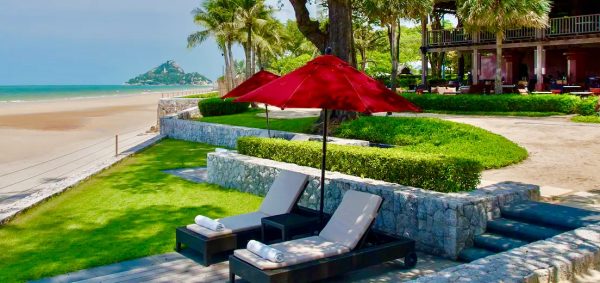HUA HIN, 6 JUNE 2025: Tucked away on the Gulf of Thailand, just a few hours from Bangkok, Hua Hin remains one of the kingdom’s most alluring coastal towns — a sanctuary where timeless elegance meets serene simplicity.
My recent stay in Hua Hin, beginning in mid-May, reaffirmed the reasons I call this place my “happy place.”

The gentle lapping of waves, early morning walks along the shoreline, and the peaceful cadence of tropical life offered a stark contrast to the world’s current uncertainties. From my vantage point at the Hyatt—overlooking lush gardens, lotus ponds, and the saltwater scent of sea air— Hua Hin reminded me of Thailand at its best: graceful, welcoming, and quietly resilient.
A Season of Reflection
This visit came at a particularly poignant time for Thailand. In March, a powerful 7.7 magnitude earthquake in neighbouring Myanmar sent tremors through much of the region, shaking buildings in Bangkok and stirring unease across the kingdom. It was a stark reminder of how quickly the equilibrium of daily life can shift.

Yet, as always, the Thai spirit endures. Communities rallied. The government acted swiftly. And across the tourism sector, new safety protocols and messages of reassurance were implemented. Hua Hin, with its royal legacy and gentle pace, felt like a fitting place to pause, reflect, and consider not only what’s been lost — but what may yet be regained.
The Economic Engine at Risk
Tourism has long been one of Thailand’s most significant economic drivers, contributing nearly 20% of the country’s GDP and employing millions across both urban centres and rural provinces. Before the pandemic, the sector generated over 3 trillion baht annually in direct and indirect revenue. With foreign arrivals dipping 1.75% year-on-year as of mid-May, and some analysts suggesting that annual tourism arrivals might only match last year’s figure—the immediate economic loss, against its planned revenue, is therefore staggering.
In 2024, Thailand experienced a robust resurgence in its tourism sector, welcoming approximately 35.54 million international visitors — a 26.3% increase compared to 2023. This influx generated over THB1.7 trillion (approximately USD51.81 billion) in revenue, underscoring the sector’s pivotal role in the nation’s economic recovery.
The top source countries contributing to this growth were China (6.7 million visitors), Malaysia (4.93 million), and India (2.12 million). Strategic government initiatives, such as visa exemptions for citizens of 93 countries, significantly enhanced travel convenience and encouraged more visitors to choose Thailand.
Domestically, Thai residents made approximately 198.69 million trips, contributing an additional 952.77 billion baht to the economy. Collectively, both international and domestic tourism activities in 2024 generated a total revenue exceeding 2.75 trillion baht, highlighting the sector’s substantial contribution to Thailand’s economic landscape.
Looking ahead, the Tourism Authority of Thailand (TAT) has set ambitious targets for 2025, aiming to attract between 36 and 39 million international visitors and generate up to 2.23 trillion baht in tourism revenue.
But the real danger lies in long-term erosion: not just of revenue, but of global competitiveness, investor confidence, and industry morale.
Here’s the paradox: while the losses amount to trillions, the required investment to pivot and rejuvenate the sector could be relatively modest in comparison. A government or private sector infusion of just 100–200 billion baht—a fraction of annual tourism revenues — could fund sweeping changes, from digitisation and marketing to upskilling labour and creating crisis-resilient infrastructure.
This is not just about plugging gaps but about leveraging a slowdown to reimagine the future of Thai tourism. Here are five possible directions for the development of Thai tourism.
Diversify Source Markets Beyond China and Russia
Over-reliance on a few key markets makes the sector vulnerable to geopolitical and economic swings. Greater focus on India, the Middle East, Eastern Europe, and high-spending travellers from the EU and North America can spread risk and increase average per-trip expenditure.
Develop year-round domestic tourism incentives
Supporting Thai travellers with seasonal incentives and domestic tourism campaigns can stabilise occupancy during shoulder and low seasons. Creating loyalty programmes or tax rebates for local travellers could go a long way.
Upgrade infrastructure and digitisation
Seamless travel experiences — from e-visas to smart airports and real-time transport integration — are essential. Investing in AI-powered visitor services, multilingual content, and efficient public transportation in tourist areas could significantly elevate Thailand’s competitiveness overnight.

Promote sustainable & community-based tourism
Eco-conscious travellers are looking for meaning, not just luxury. Hua Hin and similar towns can promote authentic, low-impact experiences—such as homestays, local crafts, and conservation tourism—while supporting rural economies and mitigating overcrowding in popular destinations.
Establish a national tourism innovation fund
A public-private investment vehicle could support small and medium-sized enterprises (SMEs) in the hospitality and travel sectors with grants, training, and innovation hubs. Focus areas could include green tech, accessibility for seniors and people with disabilities, and wellness-oriented travel.
Why Hua Hin still matters
In an uncertain global landscape, Hua Hin continues to offer rare clarity, calm without sterility, and tradition without the trappings of cliché. In Hua Hin, I enjoyed peaceful afternoons by the lagoon pool and evenings filled with jazz and sea breezes; I rediscovered not only a destination — but direction.
The Thai tourism industry has been knocked off balance, yes — but it is not broken. With strategic thinking and modest but meaningful investment, it can rise stronger, smarter, and more inclusive than before. And towns like Hua Hin, quiet stars in the national constellation, will be vital in guiding that journey forward.
About the author
Andrew J Wood is a respected travel writer, hotelier, and tourism lecturer with over four decades of experience in Southeast Asia’s hospitality and tourism sectors. A former general manager of several leading hotels in Thailand and a regular speaker at international tourism forums, he is widely recognised for his insight into emerging travel trends and his passionate advocacy for Thailand as a world-class destination.






